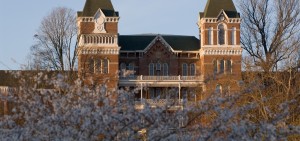A major redevelopment plan for The Ridges includes senior housing and small businesses
By: Gabriel Scotto
Posted on:
ATHENS, Ohio (WOUB) — Ohio University recently unveiled a plan to redevelop The Ridges into affordable housing for seniors and families, artist live-work spaces and owner-occupied businesses.

It is estimated the plan will take seven to 10 years to complete and cost $227 million, with $180 million of that earmarked for economic development in Athens County. The Voinovich School estimates the total economic impact of the plan overall will be $330 million.
“This project will be a combination of tax increment funding, historic rehabilitation credits at the federal level, low-income housing tax credits and public bond financing through a new community authority, which will have three partners,” explained Dominick Brook, director of real estate at Ohio University.
The three partners behind this community authority will be the university, the city of Athens and Community Building Partners, a Columbus-based nonprofit.
“The framework plan set out to develop a long-term use for The Ridges, to understand all the acreage that we have and all the buildings, how they’re used and how they support the university’s mission, while recognizing that the quantity of all of the land and the buildings was more than the university could use,” said Shawna Wolfe, associate vice president for university planning.
The university has already repurposed Ridges buildings 21 and 22, along with investing in buildings 13, 14 and 18 and completing stabilization projects and enhancing connectivity on The Ridges campus.
However, with a limited budget for rehabilitation and over 700,000 gross feet of space that had not been invested in for years prior to the state transfer of The Ridges, Ohio University was forced to seek help from external developers.
“The framework plan sets out to understand how external investments can help meet the needs of reinvestment into The Ridges,” said Wolfe. “We called it a ‘framework plan’ because what we did is really designate the qualities and attributes of the land and the buildings and what they could be suited for in the future.”
While prior proposals looked at the demolition of some buildings, a study commissioned by Community Building Partners has found this won’t be necessary.
“When you look at the buildings and look at potential uses, there’s a complimentary use for every building on the historic campus,” said Joe Recchie, CEO of Community Building Partners.
Recchie said the money invested into The Ridges will benefit the Athens community long-term.
“[Appalachia’s] rich with historic buildings. The historic buildings have incentives that attract corporate investment,” said Recchie. “They bring their money into the community and it’s permanent. It can’t be extracted from you and taken elsewhere.”
While the buildings are robust and historic, they require substantial investment. The cost of reconfiguring them to a modern use is also expensive. Brooke said this was a stumbling block for potential developers.
“Prior to working with Community Building Partners, we’d met with scores of developers and walked them through the facilities,” said Brooke. “What we heard from them was: ‘It’s too large and too big a risk. The buildings are very old, they’re difficult to rehabilitate and reconfigure to a new use.’”
The university will continue to own and operate all the buildings that it currently occupies on The Ridges. Meanwhile, senior housing will be constructed in buildings two, three and four. This will be followed by artisan live-work studios, retail and restaurants, along with a limited number of townhomes and family housing along Dairy Lane.
Despite these ambitious plans, only 100 acres out of a total of 700 are to be developed. The remainder is natural space that will be left untouched.
For Shawna Wolfe, the framework plan represents the culmination of a 30-year infatuation with The Ridges.
“My love for the Ridges started in 1993, when I was a student at Ohio University. I had the ability to walk through these buildings, not knowing that one day I’d be the university planner,” she said.
Wolfe, who has been involved with proposals to develop The Ridges since 2006, says the main obstacle to previous proposals was financing, something that the framework plan takes into account.
“Before I came on, there were lots of proposals. Local community members and even university members considered turning part of The Ridges into a golf course. There’s been various framework plans in the past or master plans that looked at demolishing buildings,” said Wolfe. “But what they didn’t do is all the financial preparation work that Dominick and his team have done to look at financially viable plans.”
While Wolfe said the university has figured out a strategy to move its plans to develop The Ridges forward, there are still many obstacles, and it is by no means guaranteed. Nevertheless, Wolfe said the framework plan represents “the best potential solution” for development.
“I think our biggest thing is knowing how many thousands and thousands of hours have gone into developing this plan, not just by us, but by community members,” said Wolfe. “And it feels really great that there’s an opportunity to continue the investments that we’ve already been making. I hope there’s a recognition of all the work that has been invested and everything that has been saved and what will happen with this project as it continues through its approvals.”

